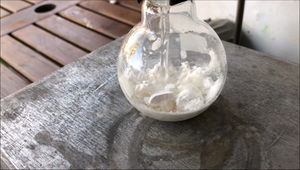Sodium methoxide
 Freshly prepared sodium methoxide
| |
| Names | |
|---|---|
| IUPAC name
Sodium methoxide
| |
| Other names
Methoxysodium
Sodium methanolate Sodium methylate | |
| Properties | |
| CH3ONa | |
| Molar mass | 54.02 g/mol |
| Appearance | White solid |
| Odor | Odorless |
| Density | 1.3 g/cm3 |
| Melting point | 127 °C (261 °F; 400 K) |
| Boiling point | > 300 °C (572 °F; 573 K) |
| Reacts | |
| Solubility | Reacts with carboxylic acids, halocarbons, mineral acids Soluble in DMSO, ethanol, lipids, methanol, oils Slightly soluble in pentane |
| Hazards | |
| Safety data sheet | Sigma-Aldrich |
| Related compounds | |
| Related compounds
|
Sodium ethoxide |
| Except where otherwise noted, data are given for materials in their standard state (at 25 °C [77 °F], 100 kPa). | |
| Infobox references | |
Sodium methoxide is a chemical compound with the formula CH3ONa. It is a dangerously moisture-sensitive caustic base, widely used in organic chemistry.
Contents
Properties
Chemical
Sodium methoxide hydrolyzes on contact with water, forming sodium hydroxide and methanol. The reaction gives off lots of heat, which may ignite the methanol vapors.
- CH3ONa + H2O → NaOH + CH3OH
Reaction with halocarbons will give orthoesters, such as trimethyl orthoformate from chloroform:
- 3 CH3ONa + CHCl3 → HC(CH3O)3 + 3 NaCl
If sodium methoxide reacts with an alkyl halide, a methyl containing ether will be formed. This reaction is very useful when making asymmetrical ethers, which are difficult to prepare, such as methyl tert-butyl ether:
- CH3ONa + (CH3)3C-I → (CH3)3COCH3 + NaI
This reaction is called Williamson ether synthesis.
Sodium methoxide will react with carboxylic acid to give esters:
- CH3ONa + CH3COOH → NaOH + CH3COO-CH3
Physical
Sodium methoxide is a colorless solid, which hydrolyzes in contact with water, but is soluble in alcohols.
Availability
Sodium hydroxide can be purchased online from suppliers, but due to its hazards it's relative difficult to get hold of.
Preparation
Sodium methoxide can be prepared by slowly and carefully adding metallic sodium to an excess of anhydrous methanol. The resulting sodium methoxide can be purified by recrystallizing it from solution.
- CH3OH + Na → CH3ONa + ½ H2
Since this reaction produces hydrogen and lots of heat, it's best to perform it in an ice bath, best in an oxygen-less atmosphere, in a well ventilated area.[1]
A more safe route involves the reaction of sodium hydroxide with anhydrous methanol, in the presence of a desiccator, such as molecular sieves. In a flask, add 200 ml of anhydrous methanol and 40 g of sodium hydroxide and begin stirring until it completely dissolves. After it dissolved, add 100 g of dried 3A molecular sieves. Seal the flask, mark the methanol level and wait a few days. After the level of the methanol no longer decreases, filter the resulting solution and recrystallize the sodium methoxide. If the solution wasn't dried completely, simply change the sieves and repeat.
Projects
- Make orthoformate esters
- Make esters
Handling
Safety
Sodium methoxide is caustic and contact with skin will cause chemical burns. Reaction with water will give methanol and lots of heat, which may ignite the methanol vapors.
Storage
Sodium methoxide should be stored in air-tight containers, or in a desiccator.
Disposal
Sodium methoxide can be neutralized by dissolving it in large amounts of water slowly, then neutralize the resulting sodium hydroxide with a weak acid or sodium bicarbonate.